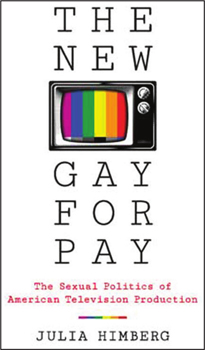Book Review
Himberg, Julia. The New Gay for Pay: The Sexual Politics of American Television Production. (Austin: University of Texas Press, 2017.)
Skip other details (including permanent urls, DOI, citation information)
: This work is licensed under a Creative Commons Attribution-NonCommercial-NoDerivatives 4.0 International License. Please contact [email protected] to use this work in a way not covered by the license.
For more information, read Michigan Publishing's access and usage policy.
In their 2001 essay titled, simply, “Media,” Curtin and Streeter argue that “[t]he media are not a pre-given ‘thing’ out there, but are themselves a politically constituted set of institutions that develop in response to a complex array of forces.” They also assert that any useful progressive politics of the media will investigate the production processes responsible for shaping the images we see.[2] After all, media texts are the results of social processes in which people “with identifiable interests, skills, and weaknesses” work together and create a commodity for public consumption.[3] In The New Gay for Pay: The Sexual Politics of American Television Production, Julia Himberg employs a “production-of-culture-perspective”[4] to reveal insider dynamics as well as the influence of capitalism and institutional structures on the creation of LGBT TV content.
In her debut book, Julia Himberg draws from her background in critical media studies to present a series of carefully contextualized case studies that demonstrate how each production story relates to larger academic debates, systems of sexual politics, and the political economy of contemporary TV. Himberg’s goal in this project is to understand how TV influences society’s commonly held ideas about sexuality; she argues against critics who focus solely on TV exploitation of the LGBT community for profit and believes, instead, that the TV industry is an “intermediary or an interpretive space between the co-optation and the facilitation of LGBT politics.”[5] To substantiate this, Himberg interviewed a range of professionals involved in making important decisions about LGBT cultural representations, including TV producers, network executives, media advocates, political consultants, public relations experts, and market researchers.
Each of the book’s four chapters stands on its own and allows readers to dive into Himberg’s rich analysis of her selected case studies: cable TV’s use of lesbian programming, same-sex marriage activism connected to ABC’s hit sitcom Modern Family, “under-the radar” activism of some industry workers, and televised commercials involved with California’s Proposition 8 ballot initiative. In each example, Himberg explains how industry professionals are “mediators of sociopolitical life.”[6]
As an example, in chapter 1, Himberg discusses how lesbian sexuality became an “edgy” marketing tool for cable networks looking to draw in audiences that support the “politically progressive social values” matching certain networks’ branding. By offering a very particular type of lesbian representation—upper class, feminine, stylish—networks such as Bravo and Showtime matched the perceived tastes of their desired audiences while at the same time shaped cultural stereotypes of lesbians. Himberg demonstrates how market research is used to inform networks of positive audience characteristics and how the research itself “shapes images of consumers to make them identifiable and sellable to advertisers.”[7] One fascinating revelation Himberg documents in the book is how one market research firm allows businesses to sponsor questions in the annual surveys it conducts on LGBT consumer behavior. These questions feature references to specific products, thereby constructing an association between these products and the respondents completing the survey. Himberg uses Absolut Vodka’s linking to the LGBT community through market research data collection as one example of this business practice. In this way, Himberg convincingly shows how cable TV’s lesbian programming is at the intersection of industry practices, branding strategies, and market research and how these behind-the-scenes decisions shape cultural understanding of LGBT identity.
Another contribution to the literature involves Himberg’s acknowledgment that LGBT advocacy groups are employing new methods in their work with the TV industry. In the past, advocacy groups were more likely to organize boycotts, use mainstream news media, or work directly with networks and creators to shape content consistent with their goals. While some organizations like GLAAD continue to work directly with TV content producers (Himberg describes some of this work), the ACLU and HRC both sponsored online campaigns supporting marriage equality using elements of the show Modern Family without the official involvement of the show or network. Himberg argues that the rationale for this approach relates to the rise of digital media, deregulation of media ownership, and marketing practices. Specifically, she describes how deregulatory changes in media ownership throughout the late twentieth century led to remarkable changes in the business of TV, including increased use of social identities and lifestyle categories to target niche audiences. As TV’s reach expanded onto the internet for deeper audience engagement, advocacy groups recognized the opportunities afforded by increased access to desirable younger viewers through these online outlets. Thus, advocacy groups can communicate political messages, recruit new members, seek funding, and rebrand themselves as relevant to young voters by communicating with these audiences online in relation to their favorite TV programs.
Undoubtedly, the book’s greatest strength is Himberg’s ability to integrate a wide variety of literature into a highly engaging, readable text. This book will appeal to those interested in critical TV studies, media activism, and how cultural understandings of the LGBT community gain power. It would be an excellent text for an advanced undergraduate or graduate course focusing on minority representation in the media, especially because it goes beyond textual analysis and offers insight into production processes without overlooking appropriate critiques of their final products. Himberg offers a strong overview of LGBT media scholarship, and readers new to this area of study will still find the book accessible while engaging with key concepts in the field.
Unlike macro-analyses of institutional processes, “studying up,” as Himberg describes, allows her to uncover production processes by hearing directly from the powerful people involved. This, however, is where the book could use additional depth. Very little interview data are included in the text, so it is difficult to completely understand the impact of the interviews because Himberg offers only sparse descriptions of them. Scholars trying to access media industry workers have historically experienced difficulty getting beyond gatekeepers, but Himberg was able to access some extremely influential people. One is left wondering how, exactly, she gained access? How was she able to get busy media professionals to dedicate so much time to interviews for a scholarly endeavor? Can readers trust that the industry professionals’ comments are not simply corporate-sanctioned publicity? Himberg provides interviewees’ current (or recent) job titles but more contextualization, such as who these people are, what led them to this kind of work, and whether their views on LGBT politics unique within the industry are needed to fully complete the picture. While this field is certainly in need of more empirically based analyses engaging directly with industry professionals, good qualitative research requires additional description and reflexivity on the part of the researcher to allow readers opportunities to evaluate the data.
Despite this weakness, Himberg’s analysis is thorough and The New Gay for Pay offers readers several thought-provoking case studies regarding the roles the TV industry plays in shaping public perception of the LGBT community and sexual politics.
Kathleen Farrell is an Associate Professor of Sociology at Colby–Sawyer College in New London, NH, whose work has appeared in the journal Sexualities and Gender, Race, and Class in Media: A Critical Reader, Third and Fourth Editions (Eds. Dines and Humez). Her dissertation also examined the “backstage politics” of creating LGBTQ media content.

Michael Curtin and Thomas Streeter, “Media,” in Culture Works: The Political Economy of Culture, ed. Richard Maxwell (Minneapolis: University of Minnesota Press, 2001), 226.

Richard Maxwell, “Why Culture Works,” in Culture Works: The Political Economy of Culture, ed. Richard Maxwell (Minneapolis: University of Minnesota Press, 2001), 7.

Linda Grindstaff and Joseph Turow, “Video Cultures: Television Sociology in the ‘New TV’ Age,” Annual Review of Sociology 32 (2006): 103–25.

Julia Himberg, The New Gay for Pay: The Sexual Politics of American Television Production (Austin: University of Texas Press, 2017), 13.

Bibliography
- Curtin, Michael, and Thomas Streeter. “Media.” In Culture Works: The Political Economy of Culture, edited by Richard Maxwell, 225–49. Minneapolis: University of Minnesota Press, 2001.
- Grindstaff, Linda, and Joseph Turow. “Video Cultures: Television Sociology in the ‘New TV’ Age.” Annual Review of Sociology 32 (2006): 103–25.
- Himberg, Julia. The New Gay for Pay: The Sexual Politics of American Television Production. Austin: University of Texas Press, 2017.
- Maxwell, Richard. “Why Culture Works.” In Culture Works: The Political Economy of Culture, edited by Richard Maxwell, 1–21. Minneapolis: University of Minnesota Press, 2001.


